Disclaimer: This website contains affiliate links, from which Heritage Acres Market LLC may receive a small commission from the vendor on the sales of certain items, all at no cost to you. Please read our full disclosure for more information. Thank you for supporting Heritage Acres Market LLC!
Are you looking for a different kind of backyard chicken to join your flock? Or maybe you are just starting, and you want a sweet-natured breed for your first chicken. Silkie chickens not only have a unique appearance, but they also have cuddly personalities making them a favorite of many chicken keepers.
Is the
- Silkie chickens are a docile breed and a favorite for both children and chicken aficionados
- They are often broody and great for hatching chicks
- Silkie chickens are best kepts as pets, they are not good for egg production or meat
Table of Contents
Background & History of the Silkie Chicken
The Silkie Chicken (sometimes spelled silky chicken) has a long history. They are one of the oldest breeds in the world and were originally bred in China. In fact, you can find detailed information in ancient Chinese writings about these birds. Many Eastern cultures were all convinced that silkie chickens had medicinal powers beyond those of any other chicken breed.
Interestingly, these beliefs have been justified through recent scientific studies. The
Carnosine is used in both modern and Eastern Chinese medicine to stimulate the immune system. It has also been shown to improve memory, enhance mood, prevent aging and preserve eyesight.
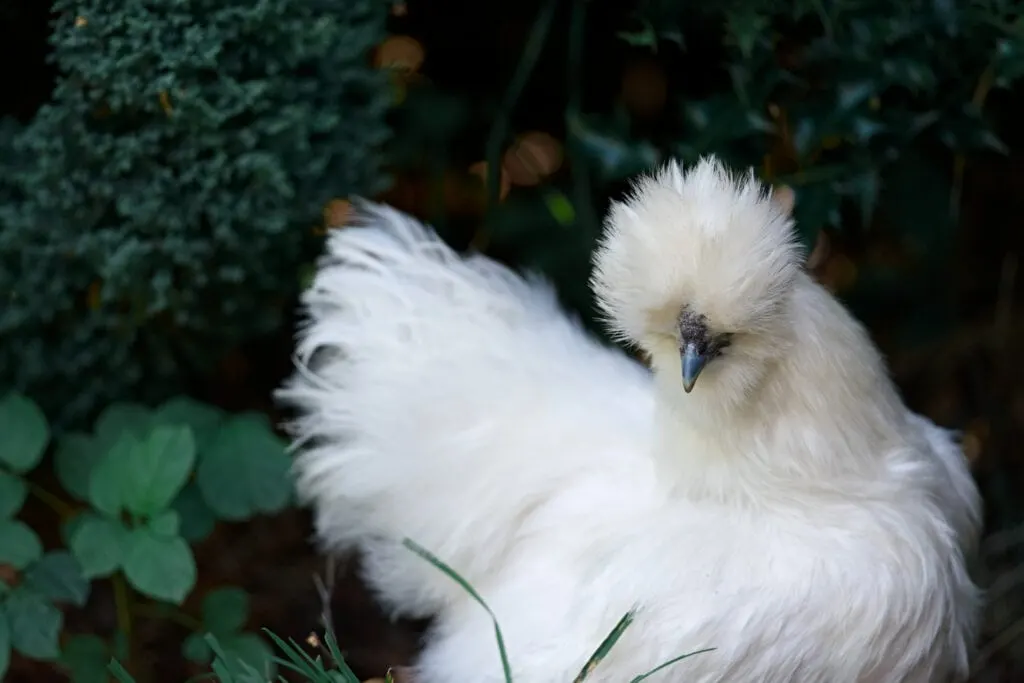
Typically, heritage breed chickens are those defined by The Livestock Conservancy. They have four common characteristics. These include:
- Recognized by the American Poultry Association Standard Breed before the mid-20th century
- They are still naturally mating
- They can live a long, productive life in the outdoors
- They grow slowly
Most importantly, they were chickens raised by our forefathers. Therefore, the
Although they have been in China for millennia, traders only introduced them to Europe in the 1800s. Due to their appearance, they became novelty birds and quickly gained popularity. That is why it was only shortly after their introduction that immigrants brought them to America. By 1872, they made a debut into the American Standard of Perfection.
Due to their popularity, this breed has always done well and is not considered threatened or endangered.
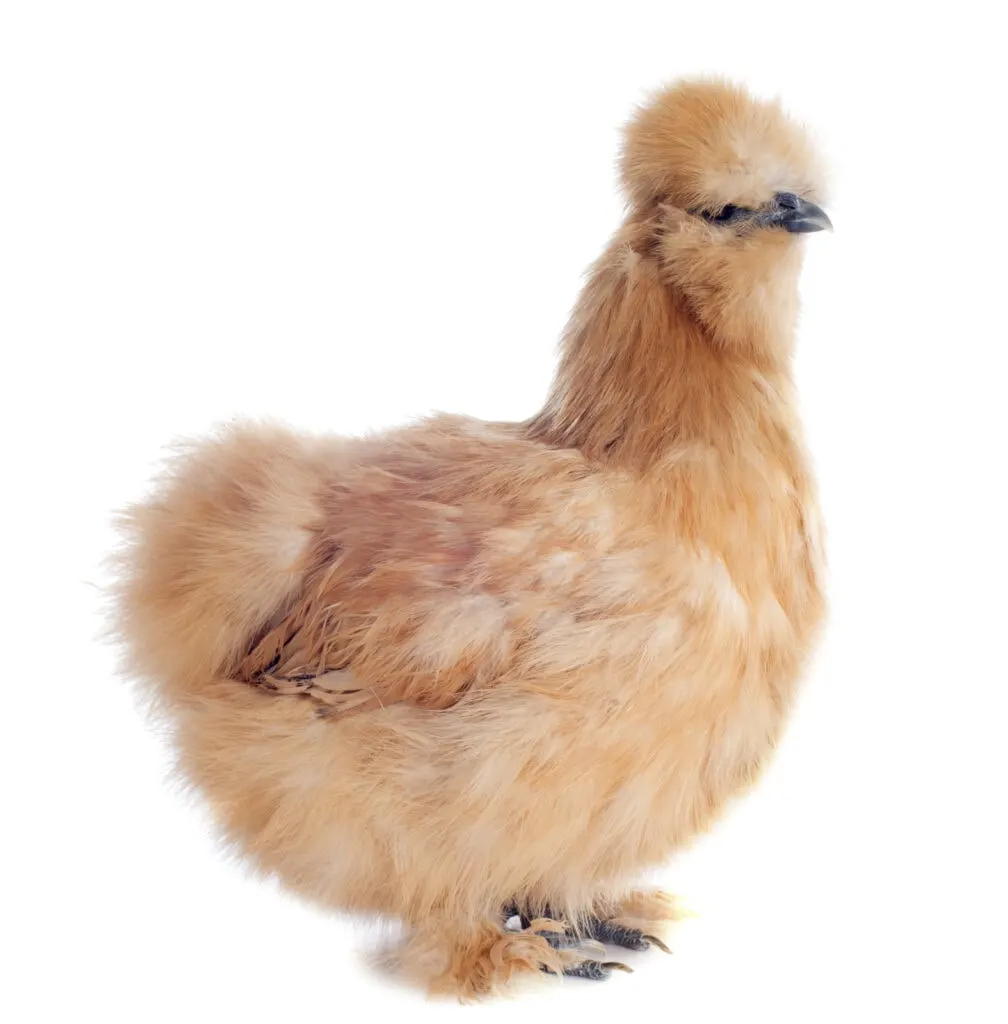
Temperament & Behavior
The temperament and behavior of the
Silkies are a docile and friendly breed, so you shouldn’t keep them with other chicken breeds who are more assertive. If you do, you will find that these poor birds often end up getting bullied. Likewise, you should avoid certain breeds like Rhode Island Red.
As long as the other breeds won’t bully them, the
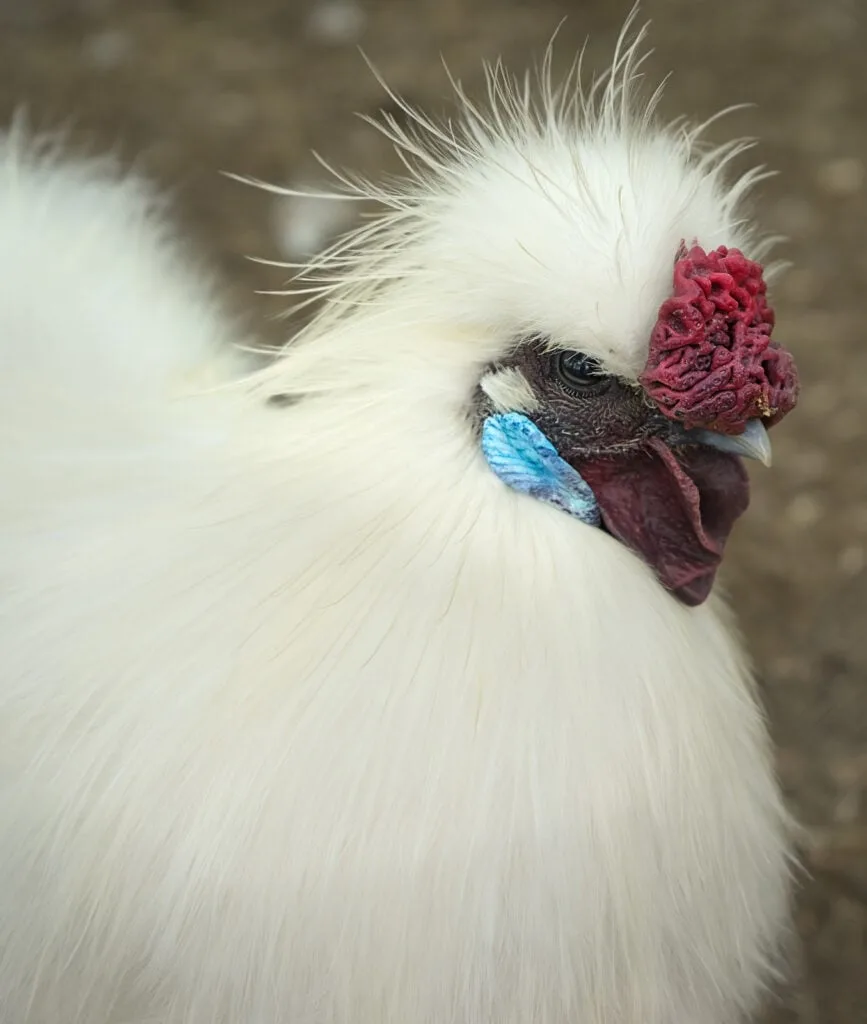
Silkie chickens are a delight to have around. Their personality makes them excellent birds for first-time owners or kids. They love getting carried around or getting a cuddle from you. These are non-confrontational chickens.
One of the other factors that endear us to the
Silkie chickens are also very quiet. Even when they do make a sound, they do it quietly, with a soft sound that suits their personalities. Their egg song, typically a staccato series of loud squawks that hens let loose once they lay an egg, is also quiet in comparison.
That being said, we should note that while hens rarely make sounds, the silkie rooster will still crow. So even though their noise level is generally less than other birds, it is still disruptive if you have nearby neighbors.
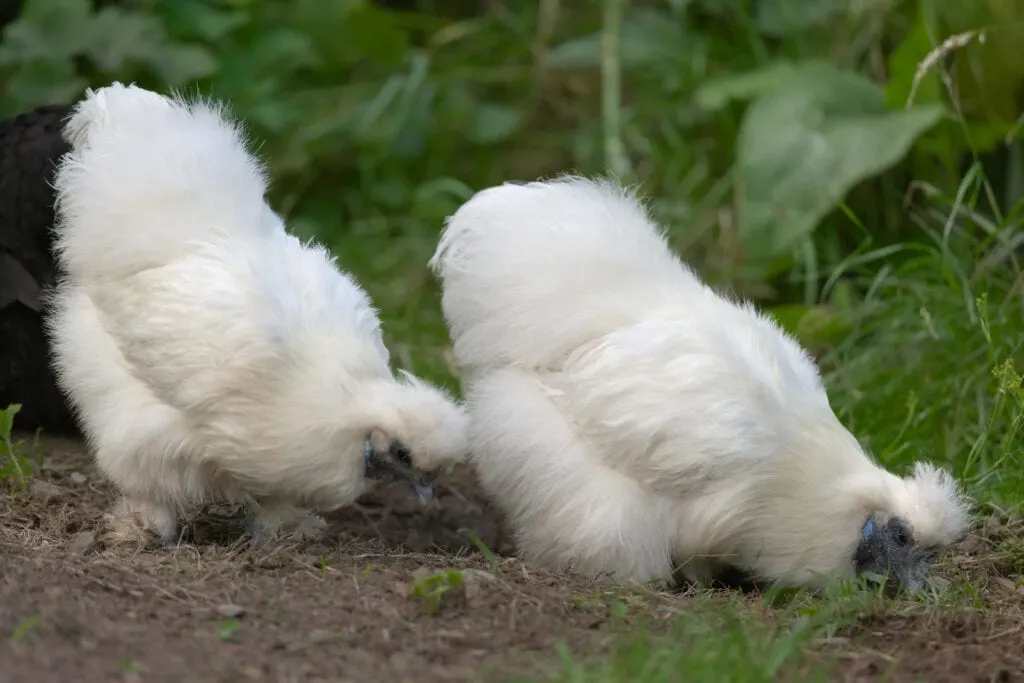
Silkie Chicken Specifics & Traits
Silkie chickens don’t only have a relatively unique personality, but they have many other defining traits and characteristics that set them apart. If you are still learning about a Silkie and its possible role on your homestead, read on to learn more about these quirky creatures.
Purposes of the Silkie Chicken
Silkies are not dual-purpose birds in the typical sense of the term. They are too small to make good meat chickens. Silkie chickens also have black skin, which some people find unappetizing. As a result, very few people raise them for this purpose since you simply won’t get enough meat from one of these sweet birds.
They do, however, make a good enough egg-layer to make them worth it on a homestead. We dig into their egg-laying more below.
In the non-traditional sense of the word, Silkie chickens do have a dual purpose as popular pets. People even own Silkies as an apartment pet chicken since they are often quieter than typical chickens. In addition, if you are trying to engage your kids with life on the farm, getting a
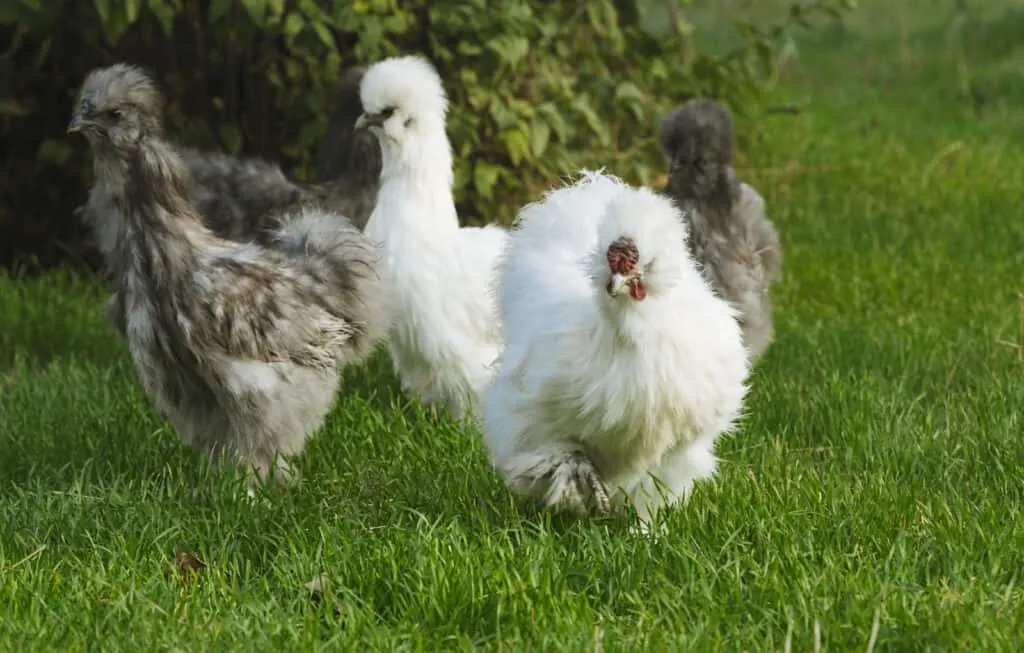
Size and Appearance of Silkie Varieties
Chicken experts accepted the
Since then, they have been recognized in other parts of the world as well. For example, they were accepted by the Australian Poultry Standard (APA) in 1998, although only the silkie bantam chicken.
This chicken breed is always considered a bantam in the US and Canada, no matter its size. The set standards will separate them into both silkie bantam and large fowl categories in any other country.
Silkie chickens have unique types of feathers. Instead of typical feathers as you would expect on a regular chicken, Silkies have hair-like, fluffy plumage all over their body. That includes their head. Conveniently, they enjoy being handled since it is so fun to pet this soft fur-like chicken.
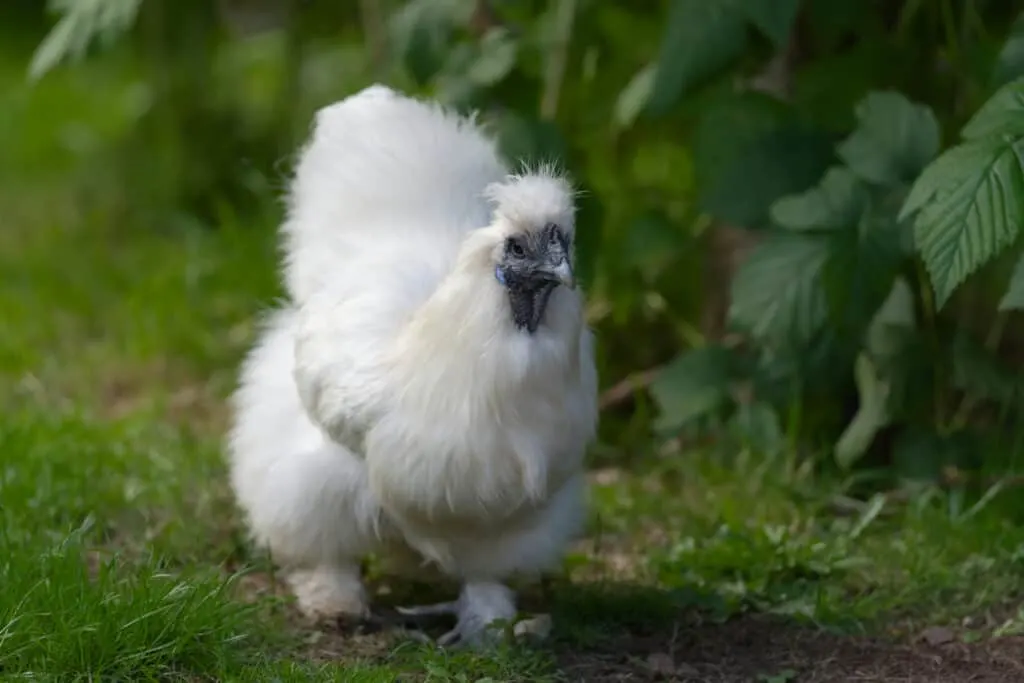
They have been called a pom-pom chicken by some since silkie feathers are unique and cover the vast majority of the chicken. In addition, Silkies have feathered legs and feet.
There are two main types of Silkie chickens when it comes to their appearance. These include bearded silkies and “non-bearded” chickens.
Bearded Silkie chickens are more common since they have the stereotypical fluffy feathers that cover their entire heads. You can only see the beak sticking out from a sea of face fluff. You can easily see the facial skin and the eyes of a non-bearded
The APA has accepted quite the variety of colors for Silkie chickens. These include:
- Black
- Blue
- White
- Buff
- Splash
- Patridge
- Grey
There are other colors for Silkie chickens, but the APA does not yet accept them. These include red, cuckoo, and lavender. The most common is the white
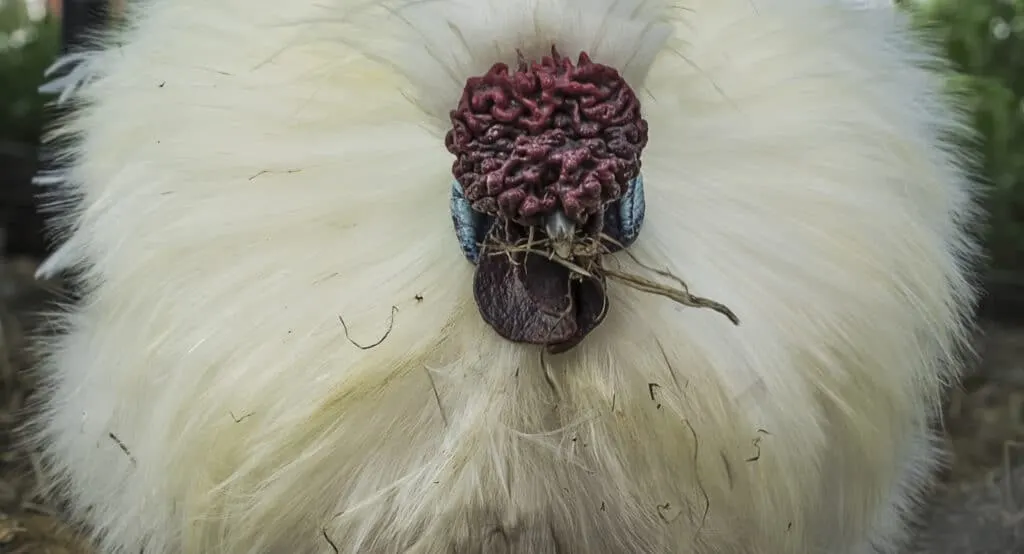
The size of a
Large fowl Silkie roosters weigh about 4 pounds, and the hens are smaller at about 3 pounds. If you have a bantam chicken, males will weigh around 600 grams and females around 500 grams.
Shortly after silkie chicks first hatch, they will have a fluffy crest on their heads. Fluff will cover the rest of their body making them look like Pom-Poms. In other words, they won’t look dramatically different from other breeds of chicks. The difference comes in when they age. Instead of losing that light fluff for feathers, they only become fluffier.
Silkie chicks might have a vaulted skull when first hatched, but they might not as well. Therefore, you can’t use this as a defining identifying factor.
Other than their unique fluffy feather type and pattern, they also have other unique genetic twists. One of these is that Silkies often have 1 or 2 extra toes on each foot. So, where the standard chicken has four toes, a
Other defining factors of the Silkie chicken are their bright blue earlobes and a mulberry red comb and wattle. These might be difficult to see if you have a bearded Silkie.

Hardiness and Health
Silkie chickens live between 7 to 9 years old, about the average life expectancy of a typical chicken.
Silkie chickens need plenty of protection. Not only are they quieter birds, but they are also quite unaware of what is going on around them. They are also not very flighty. They sometimes seem to forget they can fly. Instead, they will follow you around the yard like a puppy. However, when that comes to predators, it makes them very vulnerable.
Other than predators, there are also health issues you should keep an eye out for if you own a
Marek’s disease can end in severe egg production loss and eventually in death by wreaking havoc on the nerves of the chicken. In addition, it will ultimately cause tumors to form on major internal organs in most cases.
Another essential health factor for a
The hair-like structure of their feathers means they aren’t insulated when they get wet. As a result, they will quickly catch a chill and die of hypothermia without getting dry quickly, especially in cold climates.

Silkie Chicken Eggs
Silkie chickens generally start laying their eggs between 7 and 9 months of age. Don’t be too worried if your hens haven’t started yet, though. Some of them are pretty finicky egg layers and won’t start until they are a bit older.
Silkies are quite a bit smaller than standard breeds meant for egg-laying. As a result, the silkie egg is also noticeably smaller than eggs you will get from these breeds, such as the Plymouth Rock chicken.
Silkie chickens will lay eggs that are tinted a creamy color. They are also inferior to average layers for a homesteading chicken. They lay between 80 and 120 eggs each year. That adds up to about 2 to 3 eggs each week. Not an astonishingly good number by any stretch, and not the best choice if you are interested in egg production.
Their egg-laying often gets interrupted because they tend to go broody. So if you discourage broodiness, you might get them to lay more often.
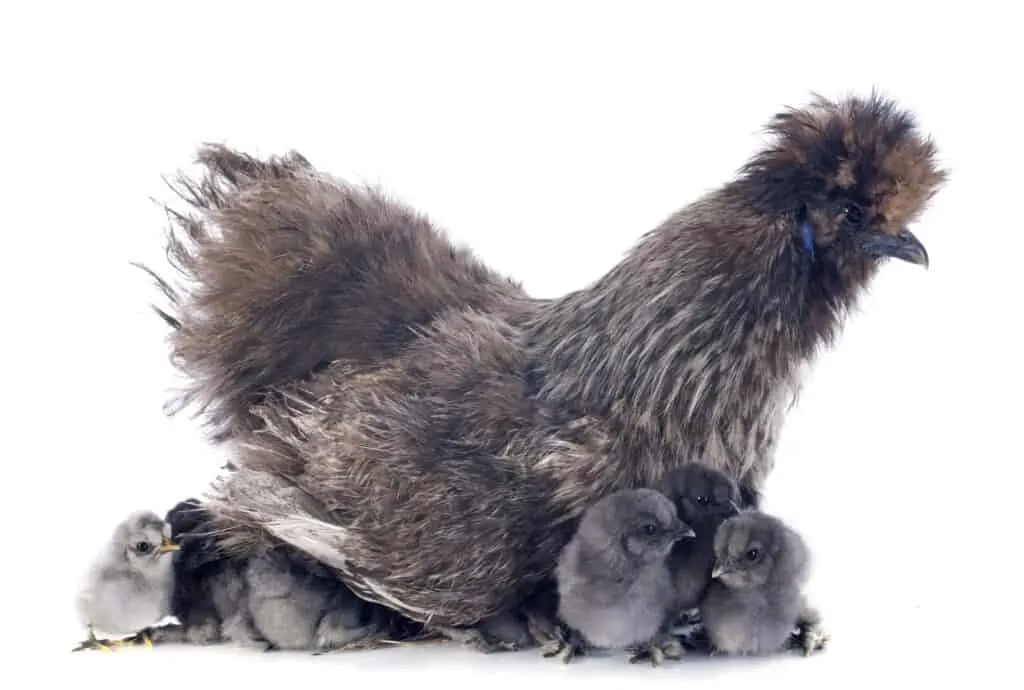
Where to Buy Silkie Chicks
Silkie chickens are relatively common, so they aren’t usually much more costly than an average chicken. However, their price is also affected by the fact that these chickens are not extremely useful other than their good looks.
If you want a show quality Silkie chick, look for a silkie breeder. You can often find them for about $10 to $15 each. However, if you opt for a full grown hen, expect to pay closer to $20 to $50.
The easiest way to find a highly rated silkie breeder or hatchery is to search on PoultryFinder.com, our online directory for breeders, hatcheries, and supplies.
You can also find full sized and bantam silkie chickens online and ready to ship to your door at Cackle Hatchery.
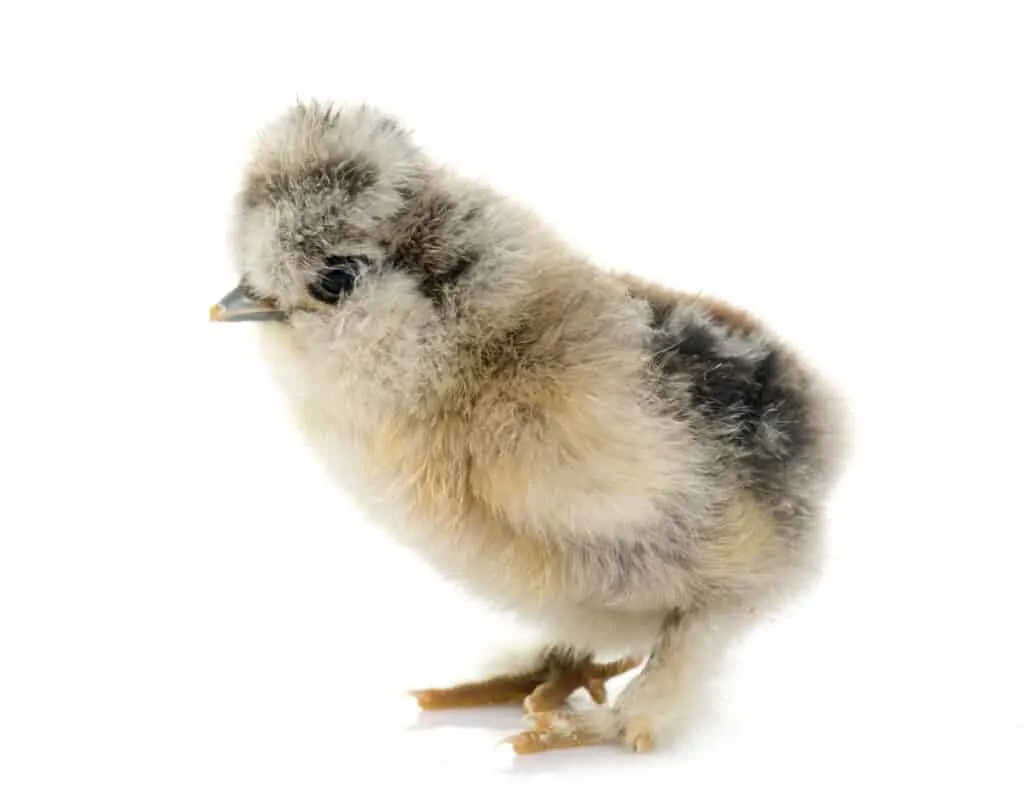
In Summary
Silkie chickens are an excellent bird to own if you want a breed that acts more like a barnyard pet. Unfortunately, they do not serve well as meat-producing birds, and they have a lower-than-average egg-laying rate. However, with their adorable personalities and friendliness, they can round out your flock of chickens.
| Breed Name | Silkie Chicken |
| Type | Pet/Companion bird |
| Size | 8-14 inches tall |
| Heritage Breed | Yes |
| Average Weight | 2 lbs (1.2 kgs) |
| Weeks To Maturity | 9-11 months |
| Average Life Span | 4 to 8 years |
| Color variations | Black, blue, buff, gray, partridge, splash, white |
| Egg Size | Small (1.25-2.5 ounces) |
| Egg Color | Cream |
| Egg Production (annual) | 100 |
| Dual Purpose | No |
| Temperament | Calm, friendly |
| Beginner Friendly | Yes |
| Kid Friendly | Yes |
| Heat Tolerant | No |
| Cold Tolerant | Yes |
| Comb Type | Walnut |
| Broodiness | Very (even without eggs) |
| Flightiness | Not very |
| Noise Level | Quiet |
| Unique Traits | Silkie feathers, turquoise earlobes, five toes, persistent broodiness, black skin |

Figure it out
Tuesday 14th of February 2023
Most people I know that keep silkies keep them because they are the best if you wish to hatch your own chicks. No need to fuss with temps or humidity. So many chicken breeds have almost had the "broody" bred out, in favor of higher egg production. As for the black skin and/or flesh, some cultures consider them medicinal.
Rubie Boisvert
Monday 21st of November 2022
I had 2 silkies , 1 roo an 1 pullet. The Rooster at 11 mos. No eggs that I know of SO adorable. I just purchased 7 and have peewee silkie farm incubating another 6 .that's chicken math .I love them .
Ashigbi Daniel
Saturday 23rd of April 2022
l enjoyed reading about the silky and would like to raise some.